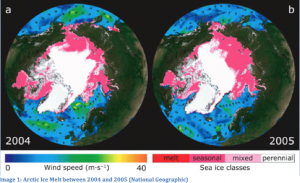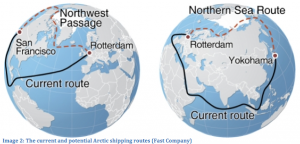By Jenna Glat ’15
Last fall, I enrolled in a fascinating Geography course called “Arctic Transformations,” taught by Professor Jessica Graybill. I assumed we would be learning about indigenous cultures, oil and gas, and climate change affecting the region, but little did I know how much this course would have opened my eyes to the environmental horrors occurring in the polar regions of our Earth. While there are many potential economic benefits that will impact nearly every other region of the globe, the harmful effects on indigenous communities outweigh the positive possibilities.
The Arctic is very much still a pristine, sparsely populated region. There are a handful of indigenous groups who reside in small villages along the coast, where they can hunt both land and marine wildlife in order to survive in a landscape containing very little vegetation. These cultures have been, and will continue to be, forced to adapt to warming temperatures and melting sea ice. Warmer air means less thick ice, which can pose a major danger to these indigenous groups, who often rely on ice stability to travel to and from different polar areas while hunting for much needed food. As Image 1 shows, the amount of perennial, or permanent, ice decreased dramatically between 2004 and 2005, and even less ice can be found today in 2014.

Image 1: Arctic Ice Melt between 2004 and 2005 (National Geographic)
With the melting of Arctic sea ice, however, comes an opportunity that major Arctic countries and stakeholders are anxiously awaiting – the opening of either, or both, the Northern Sea Route and the Northwest Passage. Completely melted ice on the periphery of countries such as Canada, Russia and various European nations will allow these major economic participants to cut their shipping routes by thousands of miles, as they will be able to pass through the Arctic region to reach American and Asian markets, rather than travel through the Panama and Suez canals, which is the only current option. This potential change in shipping options would require the discussion of various legislative items, including who “owns” the water through which these ships will pass. The United Nations Convention on the Law of the Sea, or UNCLOS, states that a country’s territory extends 200 nautical miles from the edge of their continental shelf, meaning that multiple countries could potentially claim this water space as theirs. The United States, interestingly enough, has yet to ratify UNCLOS, most likely because they are trying to figure out exactly where the continental shelf ends in attempts to claim part of the Arctic as their own.

Image 2: The current and potential Arctic shipping routes (Fast Company)
Due to the vast amounts of oil, gas, and many other natural resources available in the Arctic region, the potential for a quicker shipping route could provide huge economic incentives to the countries that are able to claim the resources and utilize the shipping routes. Large ships traveling through the Arctic region, however, pose a major problem for those who inhabit the region, both humans and animals alike. Despite being a more environmentally friendly option than planes or automobiles, ships still will create pollution in the region, and can even result in disasters such as oil spills in the event that an incident occurs. To make matters worse, there are already immense amounts of pollutants in the Arctic region, surprisingly, due to the trade winds that circulate the globe. Chemicals produced in Asia or in North America quickly travel to the North Pole through both the wind and ocean currents, and settle there in the snow and ice, where they are then ingested by animals and humans. Such chemicals can be very harmful to the health of these species, and through a process of biomagnification, in which the chemical levels increase as one moves up the food chain due to the natural cycle of animal eating patterns, indigenous Arctic communities have been found to contain dangerously high levels of contaminants in their hair, skin, and breast milk, for example.
Over the years to come, as ice continues to melt, and temperatures continue to warm, major discussions will need to be held among both developed nations who wish to own a piece of the Arctic, and the indigenous communities who reside in this region, in order to ensure that the best practices are occurring to benefit the right people.

